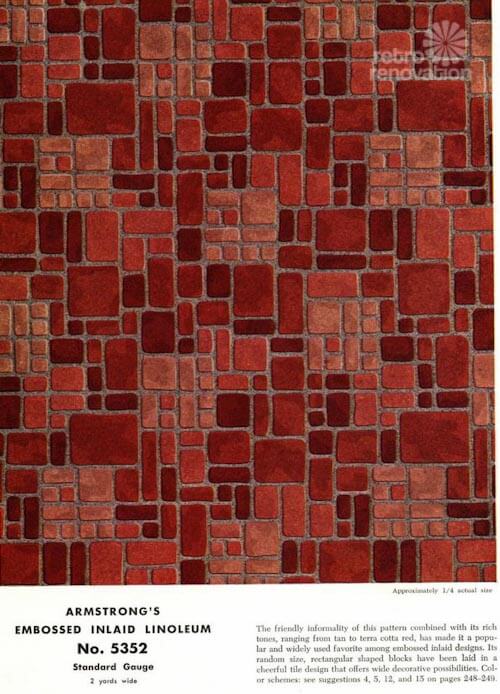 A short pause today, to reflect upon and ogle the linoleum pattern that we believe was The Single Most Popular resilient floor pattern in midcentury American houses: Armstrong No. 5352. So far in my research, I have found No. 5352 in Armstrong catalogs as early as 1935 and reader Scott says that it was still being sold at Sears in the mid-1990s! That is quite a run!
A short pause today, to reflect upon and ogle the linoleum pattern that we believe was The Single Most Popular resilient floor pattern in midcentury American houses: Armstrong No. 5352. So far in my research, I have found No. 5352 in Armstrong catalogs as early as 1935 and reader Scott says that it was still being sold at Sears in the mid-1990s! That is quite a run!
March 2020 update: Armstrong Flooring is reintroducing the 5352 design — dubbed Heritage Brick — this year. Read the full story here.
- Also read my 2020 story on the history of this pattern — from my interview with Mark Zeamer of Armstrong.
Originally, Armstrong No. 5352 was available as real-deal “Embossed Inlaid Linoleum”. Mark Zeamer told me (in interview story listed just above, “The 5352 pattern lasted a long time in many different commodities, starting out in linoleum to Coronelle to felt-backed Imperial Solarian and then jumped to vinyl into the 1970’s. It was in the 70’s that it was revived as a Rotogravure printed product in Sheet Goods and Tile.”
I have been reading Jane Powell’s excellent book, Linoleum (affiliate link). “Inlaid” means that workers actually sifted different color mixtures — up to 38 different colors per design! — onto the linoleum-sheet-in-progress. “Embossed” means that the entire piece was then pressed to create texture — in the case of No. 5352, the divits suggesting grout. Incredible workmanship required for such a “humble” material.
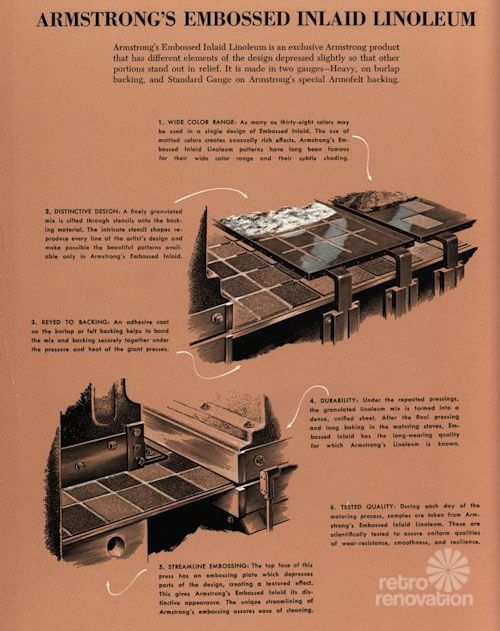
- WIDE COLOR RANGE: As many as 38 colors may be used in a single design of Embossed Inlaid. The use of mottled colors creates unusually rich effects. Armstrong’s Embossed Inlaid Linoleum patterns have long been famous for their wide color range and their subtle shading.
- DISTINCTIVE DESIGN: A finely granulated mix is sifted through stencils onto the backing material. The intricate stencil shapes reproduce every line of the artist’s design and make possible the beautiful patterns available…
- KEYED TO BACKING: An adhesive coat on the burlap or felt backing helps to bond the mix and backing securely together under the pressure and heat of the giant presses.
- DURABILITY: Under the repeated pressings, the granulated linoleum mix is formed into a dense, unified sheet. After the final pressing and long baking in the maturing stoves, Embossed Inlaid has the long-wearing quality for which Armstrong’s Linoleum is known.
- STREAMLINE EMBOSSING: The top face of this press has an embossing plate which depresses parts of the design, creating a textured effect…. The unique streamlining of Armstrong’s embossing assures ease of cleaning.
Precautionary Pam notes: I also want to relate that in her book, Powell says that while linoleum is known today for its use of renewable resources (cork, linseed oil, namely), heavy metals such as lead may have been used in the manufacturer of old linoleum. In particular, she points out that lead and other heavy metals such as cadmium and chromium may have been used in the pigments used for coloration. Resilient flooring made from other materials may have contained other hazardous materials such as asbestos; check adhesives, too. So — Precautionary Pam repeats: Be sure to test the materials in your old houses for vintage nastiness like lead, asbestos and more — get with your own properly licensed professional to determine what’s in your house and its layers, so that you can make informed decisions about how to handle. For more info and links see our Be Safe / Renovate Safe page.
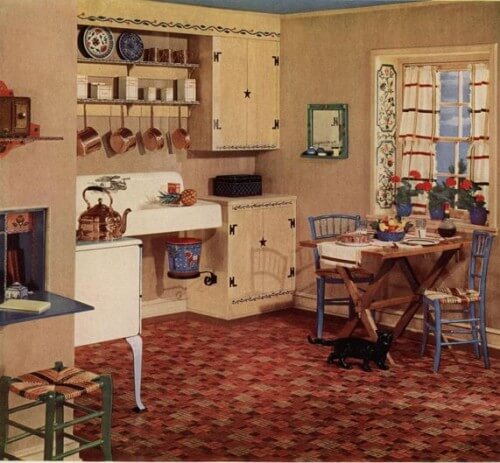
Armstrong 5352 — why was it so popular?

Armstrong pointed to its versatility, describing it as a “Tile effect with a warm informal look. Good choice for a small room, hall, den, kitchen, living room, or dining room.”
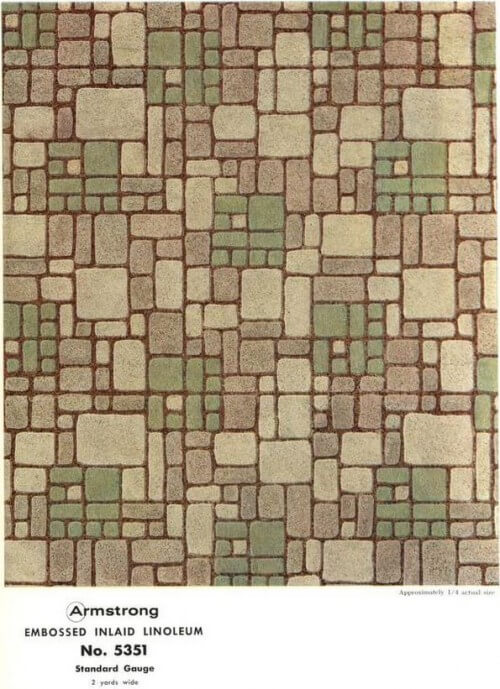
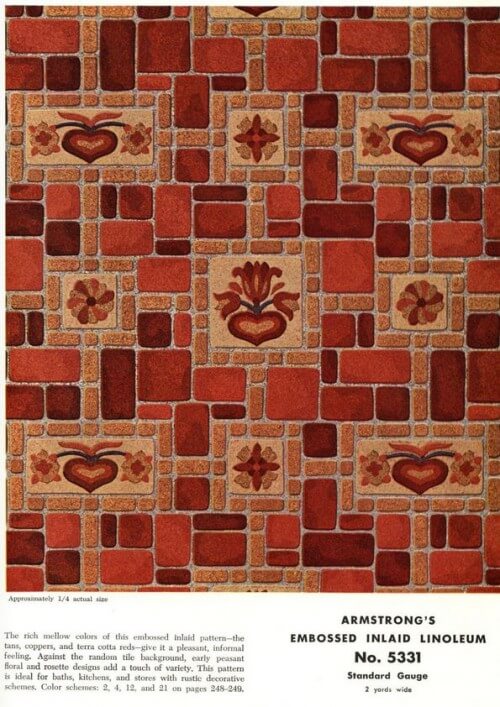
I am pretty sure that 5352 lasted well into the 1970s, at a minimum — see the photo below, Jon & Trixi found it in their 1960s house, covered up. By then, the material likely changed to vinyl or some sort of vinyl composite; test this old stuff and adhesives underneath for vintage nastiness such as lead and asbestos, too, please.
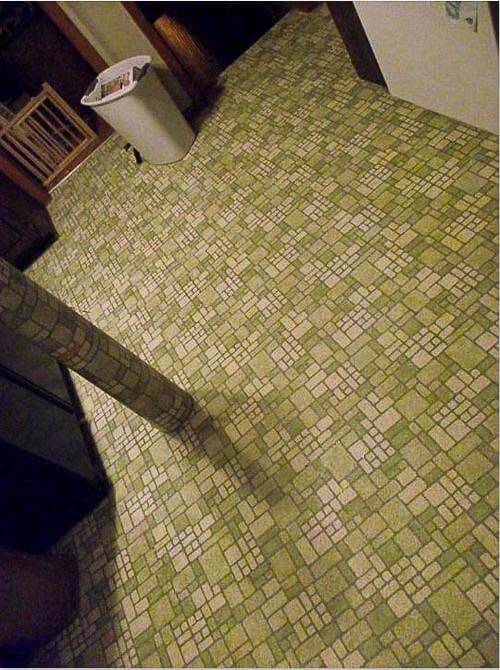
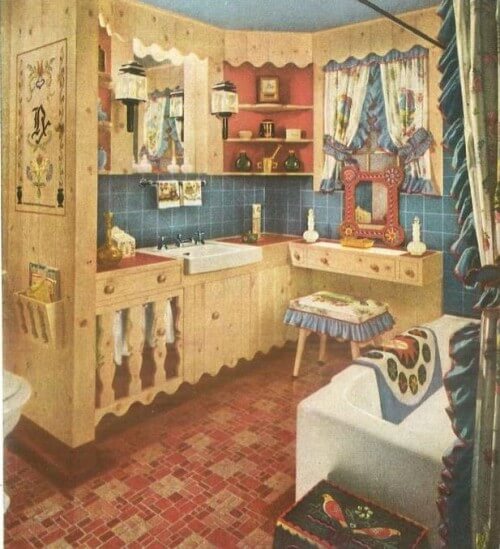
These old linoleum floors — amazingly amazing.
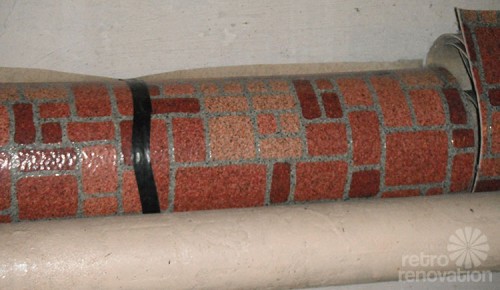
I have two partial rolls down in the basement a friend gave me. It was left in HER basement when the original owners sold them the house. Not sure what I want to do with it though. It’s not enough to cover any floor we have. I just knew I WANTED IT!



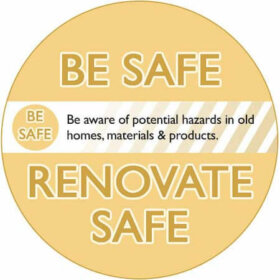
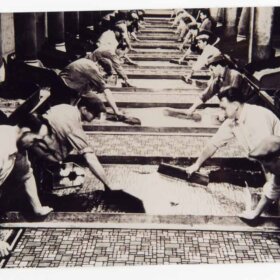
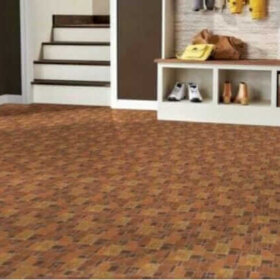
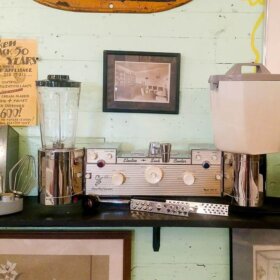
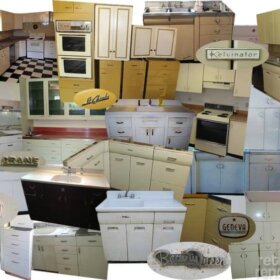

Barbara covingto says
The new pattern 5352 in the brick pattern is
not the same.. T he one I want is a darker red, I have s sample of Coral. It shows the two colors on the web page. Could you help me find it ?
pam kueber says
Here are the new colors available: https://retrorenovation.com/2020/03/30/armstrong-reintroducing-its-famous-5352-pattern-in-4-colorways-nationwide-availability-later-this-year/
Evan says
I’m thrilled to hear this! We’ve got our kitchen restoration still ahead of us, hoping to complete it by the end of the year. Flooring has been a major stumbling block. I first thought we’d go with some of the (kind of) vintage like patterns available in Marmoleum. We put that in our bathroom; not pleased. It’s very sturdy but every SINGLE drop of water shows.
At first we thought we’d do bath, kitchen and pantry all the same. But now after a year with the bathroom, no. I had about decided that we’d go with 12 x 12 VCT in some of the older style patterns but now that I’ve heard this, WHOO. Thanks for this info, I hope they have it ready by the time we need it 🙂
Pam Kueber says
For readers following this comment thread, be sure to read my story today:
Armstrong Flooring reintroducing its famous #5352 pattern in 4 colorways — nationwide availability later this year
And thanks to readers Steve and Paul, whose tips led to this story!
ANN says
The pattern was available in vinyl after the linoleum went out of production. My parents’ kitchen had the linoleum installed in the 1960’s — replacing the 1950’s vinyl after a dishwasher leak. Don’t know how many colors the linoleum came in; the dark red was the instant choice of both parents and me. When that had to be replaced, it was vinyl only, and the dark red wasn’t nearly as attractive as the linoleum version had been. My mother replaced hers with the same pattern in shades of gold, and I used the same pattern in shades of cream and almond. This was in the mid-1980s, and both floors are still in place.
Paul Steinberg, Sr. Website Administrator says
There is no question that the Colonial Classic is scheduled for production in the near future. Dr. Nick Studer from the Professional Car Society pushed hard with Armstrong, and they finally relented an notified him that preproduction samples were available for viewing. You may learn more about this at http://www.professionalcarsociety.org and this is the thread that he posted on 3/16/2020…
http://professionalcarsociety.org/forums/showthread.php?t=22779
Pam Kueber says
Wow, Paul, thank you for sharing this wonderful news! In response, I reached out to Armstrong. They confirmed that yes, a fresh version of 5352 is on the way. Stay tuned: I hope to have more information and details next week!
Susan C Neve says
I would love to cover my small kitchen and pantry with Armstrong 5352. Is there a way I can order it?
Pam Kueber says
Susan, it is no longer sold today. For my research on retro flooring options (and makers’ lineups are always changing so there could be more) see >> https://retrorenovation.com/renovate-safe/
Linda Kadyk says
I’m looking for the Armstrong 5352 linoleum. Is this something you could help me with?
Pam Kueber says
It is no longer made.
Kevin Lynch says
This print was widely used in ambulance manufacturing in the 60s and 70s. I’m referring to professional cars, i.e. Ghostbusters..the ambulances built on Caddy and other car frames. Those of us in the restoration hobby (of these cars) have given up looking. A 10′ long piece would cover the passenger compartment floor.
Steve says
I know this was used in van/truck ambulances well through the 1980s.
Word is, Colonial Classic is being reissued and will be available again!
Leslie says
For that matter, given how much greener and healthier real linoleum is (compared to vinyl), and how much deeper the pattern goes, why don’t they just start producing it again as it was?
My constant lament about everything is, “If technology is so great, how come the stuff we make now is so much worse than the old stuff?”
Pam Kueber says
Re your lament: Because planned obsolescence is more profitable, of course…
Leslie says
True, I can see that.
But even in things that are not “I will buy a replacement” items are just poorly made. Even something like a Valentine – they used to be quite cheap but were die-cut and now they come in perforated sheets of plain rectangles. I know it’s cheaper that way, but how is it that companies used to be able to make a decent profit with their higher-quality cards even without technology. You’d think technology would enable them to make at least the same quality for cheaper, but it doesn’t seem to work that way.
Wallpaper used to have all kinds of texture – and now it’s all vinyl surface. Hmmm – and now that I think of it, that’s sort of the opposite of planned obsolescence, since it lasts longer that way. (I get dizzy when I walk into a wallpaper store, from all the vinyl fumes).
I’d conclude that I’m getting crabby with age about these things, but I was crabby with youth about them, too, so I guess it’s just that I’m crabby by nature.
Pam Kueber says
I think because “Decontenting” became a thing. Now we have whole industries called “fast fashion” and the like.
Digital printed wallpaper surely must be way cheaper to produce that rotograve (I think that’s what it’s called) printing or for sure, silk screening.
Honestly, that old paper wallpaper kinda lasted forever if ya didn’t abuse it, didn’t it? I see plenty of it still up in estate sale houses. I am not sure whether today’s printed wallpaper really will last longer even with the vinyl coating.
Me crabby about such things too. That’s why I try to buy vintage.
Madeline says
WIth all the digital technology, why can’t they bring a facsimile of this pattern back?????
Pam Kueber says
I talked to the brand manager last year on another issue and expressed this exact same request. Surely it could be done flat, but for best effect it would also be great to emboss the layers — that would likely complicate matters for what could be a very low-volume product. That said, I’d settle for some plain ole red bricks to start — seems like that would have a larger audience….